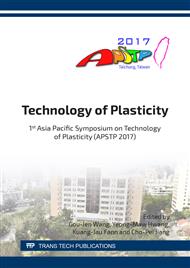p.181
p.187
p.193
p.199
p.205
p.211
p.217
p.223
p.230
Application of FEM and Abductive Network to Determine Forging Force and Billet Dimensions of Near Net-Shape Helical Bevel Gear Forging
Abstract:
In this paper, the use of the finite element method in conjunction with abductive network is presented to predict the maximum forging force and the volume of billet during near net-shape helical bevel gear forging. The maximum forging load and volume of billet are influenced by the process parameters such as modules, number of teeth, and die temperature. A finite element method is used to investigate the forging of helical bevel gear. In order to verify the prediction of FEM simulation for forging load, the experimental data are compared with the results of current simulation. A finite element analysis is also utilized to investigate the process parameters on forging load and volume of billet. Additionally, the abductive network was applied to synthesize the data sets obtained from the numerical simulation. The prediction models are then established for the maximum forging load and volume of billet of near net-shape helical bevel gear forging under a suitable range of process parameters. After the predictions of the maximum forging force and the volume of billet, the optimum of the power of forging machine and the dimensions of billet are determined.
Info:
Periodical:
Pages:
205-210
Citation:
Online since:
April 2018
Authors:
Price:
Сopyright:
© 2018 Trans Tech Publications Ltd. All Rights Reserved
Share:
Citation:


